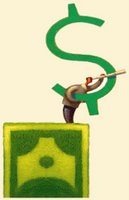Futures Market Still 100% Certain U.S. Prime Rate Will Remain At 3.25% After The August 10 FOMC Monetary Policy Meeting
 |
| Slow Economy Ahead |
And while we're on the topic of printing money (a.k.a. quantitative easing), it looks like the Fed may have to return to doing just that in order to avoid years of stagnant growth and falling prices, a la Japan.
Japan, despite super-low interest rates and quantitative easing, has been dealing with anemic economic expansion and deflation, sprinkled with the odd recession here and there, for the past 20 years. Japan's stock market has yet to return to its 1989 peak, and it has a loooong way to go. The Nikkei 225 closed @ 38,915.87 on December 29, 1989. The Nikkei is currently @ 9,489.34.
Japanese central bankers made the mistake of using freshly minted cash to prop up zombie companies and banks. They should have done a better job of spreading the cash around.
It's very clear that keeping the fed funds target rate near zero isn't going to be enough to reflate the American economy. The Fed is going to have to get more aggressive, and creative.
St. Louis Fed boss James Bullard recently produced a paper on this. Here's a quote from the abstract:
"...The FOMC's extended period language may be increasing the probability of a Japanese-style outcome for the U.S., and (2) on balance, the U.S. quantitative easing program offers the best tool to avoid such an outcome..."
I say: start the presses! But forget about dumping cash in places where it won't move. Buying long term US Treasury securities isn't going to get the economy going. Neither is buying toxic mortgages. Sure, it'll keep mortgage rates low, but the housing market is so messed up that we simply can't depend on it to make Americans feel prosperous and wealthy enough to start spending again.
Like the Nikkei, housing has a looooong way to go.
As for the banks: they continue to fail left and right, while the ones that are making it are in total survival mode, i.e. they're being extremely stingy with lending.
I say give every tax-paying American family $5,000 and strongly urge them to spend it on American goods and services. Crazy? I don't think so. And, it could even end up being a cheaper solution than all the stimulus that's been tried so far. The Treasury department could spread the $5,000 over 5 months, or $1,000 per month. Treasury would limit the money to families, but even if every taxpaying American got a check, the cost of the program would be $690 billion (as of 2007 there were 138 million taxpayers in the U.S.) Cheaper than the original cost of the TARP; way cheaper than that arbitrary war in Iraq.
And here's how to create jobs: give every business a nice chuck of change for every new hire. On top of that, offer cash for converting temporary workers to full-time employees. That'll get the unemployment rate down, fast.
Oh, and abolish all Small Business Administration (SBA) loan programs. For most businesses that need cash, these programs simply don't work. Start from scratch with a new agency that guarantees business loans, but also has a simple application process. Is "government" and "simple" akin to oil and water? Perhaps. But it doesn't have to be, especially with the menace of the double-dip looming over the American economic landscape.
Start the presses!
--
As of right now, the investors who trade in fed funds futures at the Chicago Board of Trade have odds at 100% (as implied by current pricing on contracts) that the FOMC will vote to leave the benchmark target range for the Federal Funds Rate at its current level at the August 10TH monetary policy meeting.
Summary of the Latest Prime Rate Forecast:
- Current odds that the Prime Rate will remain at the current 3.25% after the August 10TH, 2010 FOMC monetary policy meeting is adjourned: 100% (certain)
- NB: U.S. Prime Rate = (The Federal Funds Target Rate + 3)
The odds related to federal-funds futures contracts -- widely accepted as the best predictor of where the FOMC will take the benchmark Fed Funds Target Rate -- are constantly changing, so stay tuned for the latest odds.
Labels: odds, opinion, prime_rate_forecast
|
--> www.FedPrimeRate.com Privacy Policy <--
--> www.FedPrimeRate.com Privacy Policy -- BACKUP<-- CLICK HERE to JUMP to the TOP of THIS PAGE > SITEMAP < |




